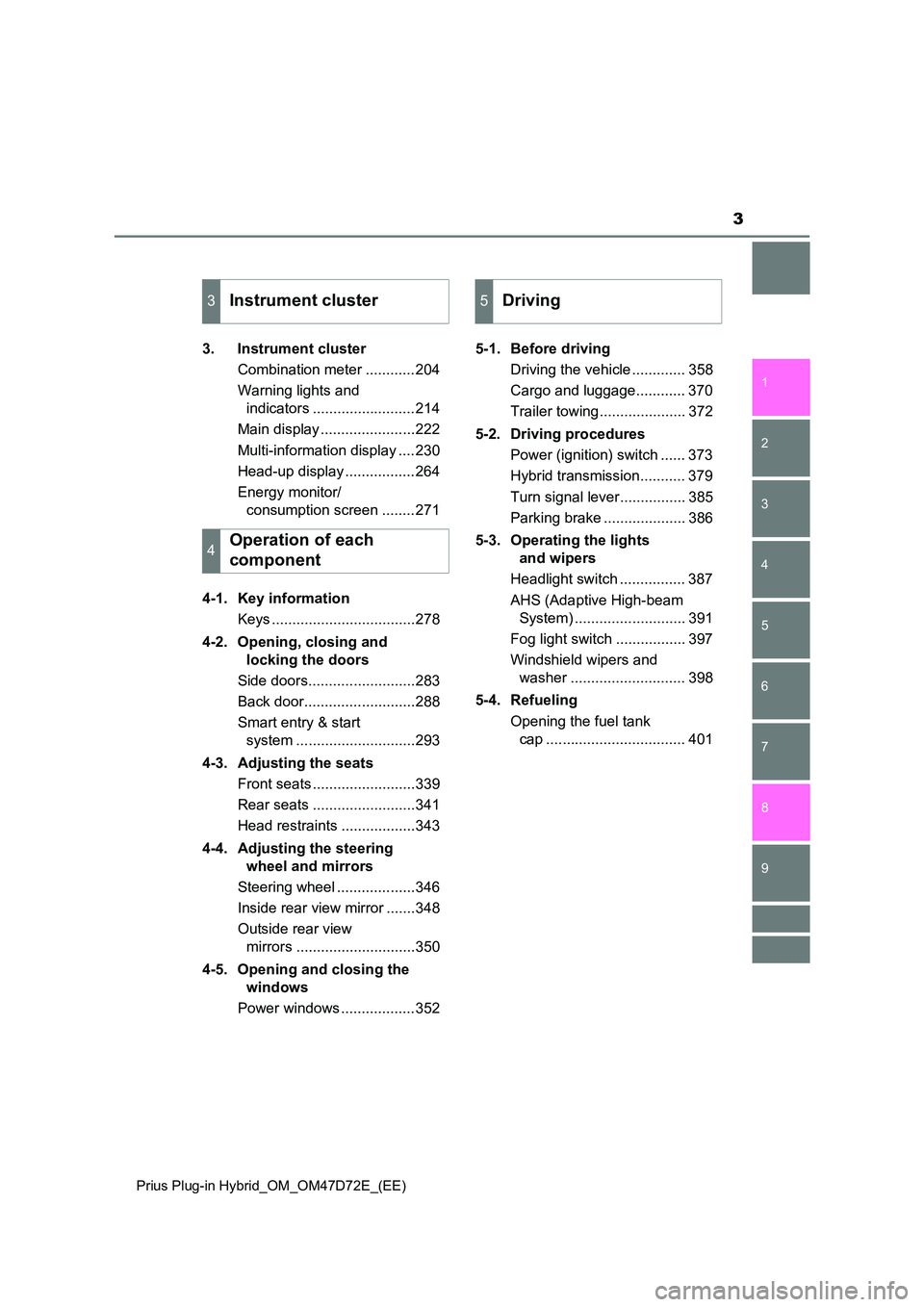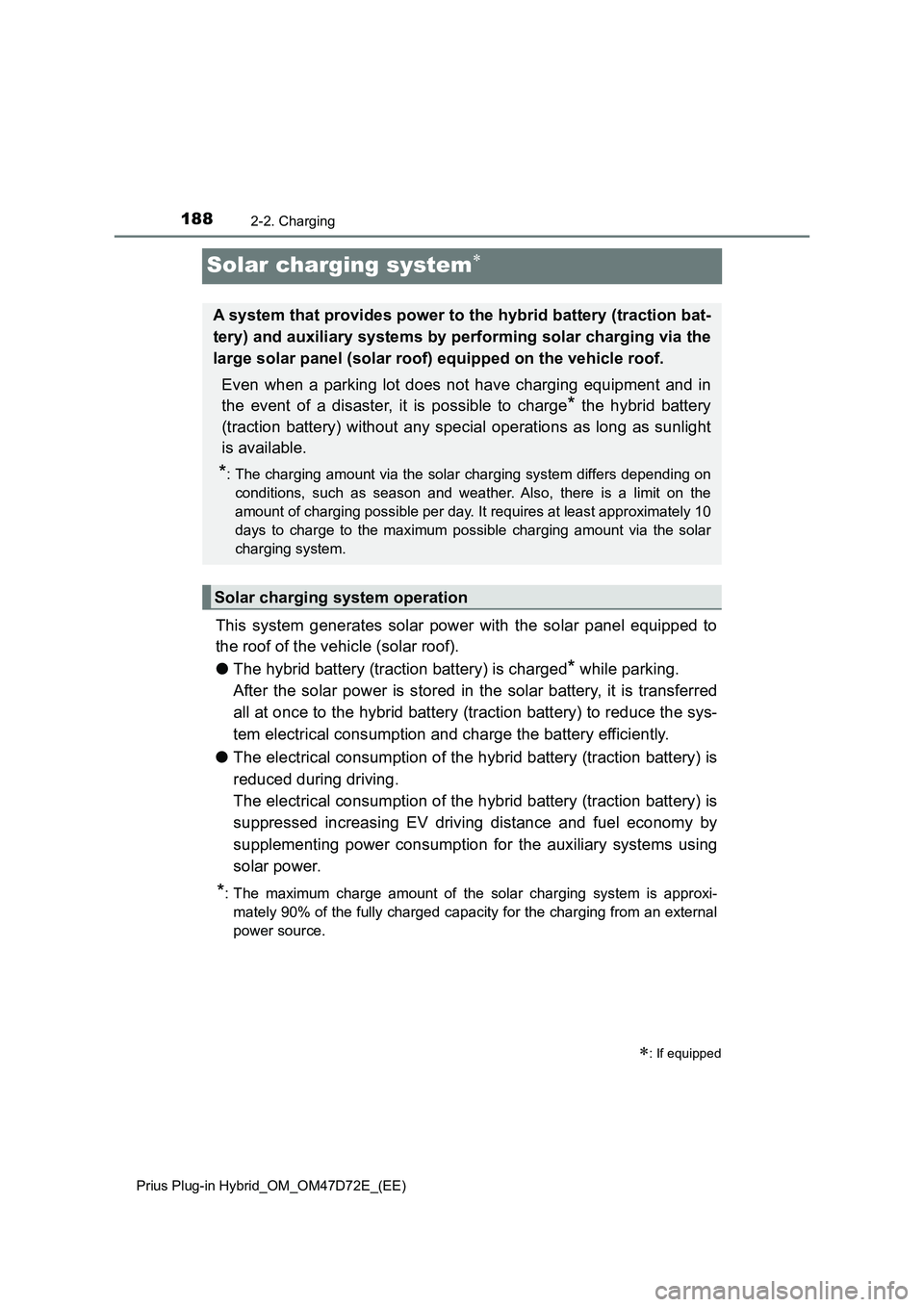2021 TOYOTA PRIUS PLUG-IN HYBRID fuel consumption
[x] Cancel search: fuel consumptionPage 3 of 816

3
1
9
8
7
6
5
4
2
Prius Plug-in Hybrid_OM_OM47D72E_(EE)
3
3. Instrument cluster
Combination meter ............204
Warning lights and
indicators .........................214
Main display .......................222
Multi-information display ....230
Head-up display .................264
Energy monitor/
consumption screen ........271
4-1. Key information
Keys ...................................278
4-2. Opening, closing and
locking the doors
Side doors..........................283
Back door...........................288
Smart entry & start
system .............................293
4-3. Adjusting the seats
Front seats .........................339
Rear seats .........................341
Head restraints ..................343
4-4. Adjusting the steering
wheel and mirrors
Steering wheel ...................346
Inside rear view mirror .......348
Outside rear view
mirrors .............................350
4-5. Opening and closing the
windows
Power windows ..................352
5-1. Before driving
Driving the vehicle ............. 358
Cargo and luggage............ 370
Trailer towing..................... 372
5-2. Driving procedures
Power (ignition) switch ...... 373
Hybrid transmission........... 379
Turn signal lever................ 385
Parking brake .................... 386
5-3. Operating the lights
and wipers
Headlight switch ................ 387
AHS (Adaptive High-beam
System) ........................... 391
Fog light switch ................. 397
Windshield wipers and
washer ............................ 398
5-4. Refueling
Opening the fuel tank
cap .................................. 401
3Instrument cluster
4Operation of each
component
5Driving
Page 97 of 816

972-1. Plug-in hybrid system
2
Plug-in hybrid system
Prius Plug-in Hybrid_OM_OM47D72E_(EE)
Hybrid battery (traction battery) charge mode (P. 9 9 )
Electricity generated in the gasoline engine can be charged in the
hybrid battery (traction battery) by switching to the hybrid battery
(traction battery) charge mode when electricity needed for EV driv-
ing is not remaining.*
●The system may not be able to switch to the hybrid battery (trac-
tion battery) charge mode due to the state of the plug-in hybrid
system. (P. 100)
●Charging time differs depending on the driving state of the vehi-
cle when driving in hybrid battery (traction battery) charge mode.
When in the hybrid battery (traction battery) charge mode, the hybrid
battery charge mode indicator illuminates.
*: When in the hybrid battery (traction battery) charge mode, the hybrid
battery can be charged while driving. However, the gasoline engine runs
to charge the battery and fuel consumption becomes higher compared
with driving in HV mode.
4
Page 102 of 816

1022-1. Plug-in hybrid system
Prius Plug-in Hybrid_OM_OM47D72E_(EE)
■When in HV mode
The vehicle can be used in the same way as a standard hybrid
vehicle.
In HV mode, controls are primarily carried out as follows in accor-
dance with the driving conditions.
●The gasoline engine stops
* when the vehicle is stopped.
●During start off, the electric motor (traction motor) drives the vehi-
cle.
●During normal driving, the gasoline engine and electric motor
(traction motor) are controlled effectively, and the vehicle is
driven with optimum fuel efficiency. Also, when necessary, the
electric motor (traction motor) operates as an electrical generator
to charge the hybrid battery (traction battery).
●When the accelerator pedal is depressed heavily, drive force
from both the gasoline engine and the electric motor (traction
motor) is used to accelerate.
*: When the hybrid battery (traction battery) requires charging or the
engine is warming up, etc., the gasoline engine will not automatically
stop. (P. 105)
■
When braking (regenerative braking)
The electric motor (traction motor) charges the hybrid battery (trac-
tion battery).
The EV driving range can be extended by actively using this regen-
erative braking to store electricity in the hybrid battery (traction bat-
tery).
Moreover, as fuel consumption is also reduced when in HV mode,
the regenerative braking system can be used effectively.
Page 115 of 816

115
2
2-1. Plug-in hybrid system
Plug-in hybrid system
Prius Plug-in Hybrid_OM_OM47D72E_(EE)
Plug-in hybrid vehicle driving tips
◆Using EV mode and HV mode effectively
Primarily using EV mode when driving in cities and using HV mode
when driving on highways (or freeways) can help conserve fuel and
electricity. (P. 98)
◆Using EV City mode
When using EV City mode, the motor output is limited and the oper-
ation of the gasoline engine can be minimized. Therefore, the vehi-
cle can be driven with only electric motor (traction motor) in city
areas, etc. (P. 98)
◆Using Eco drive mode
When using Eco drive mode, the torque corresponding to the accel-
erator pedal depression amount can be generated more smoothly
than it is in normal conditions. In addition, the operation of the air
conditioning system (heating/cooling) will be minimized, improving
fuel and electricity economy. (P. 468)
◆Use of Hybrid System Indicator
Eco-friendly driving is possible by keeping the Hybrid System Indi-
cator within Eco area. (P. 236)
◆Shift position operation
Shift the shift position to D when stopped at a traffic light, or driving
in heavy traffic etc. Shift the shift position to P when parking. When
using the N, there is no positive effect on fuel consumption. In the
N, the gasoline engine operates but electricity cannot be gener-
ated. Also, when using the air conditioning system, etc., the hybrid
battery (traction battery) power is consumed.
For economical and ecological driving, pay attention to the fol-
lowing points:
Page 116 of 816

1162-1. Plug-in hybrid system
Prius Plug-in Hybrid_OM_OM47D72E_(EE)
◆Accelerator pedal/brake pedal operation
●Drive your vehicle smoothly. Avoid abrupt acceleration and
deceleration. Gradual acceleration and deceleration will make
more effective use of the electric motor (traction motor) without
having to use gasoline engine power.
●Avoid repeated acceleration. Repeated acceleration consumes
hybrid battery (traction battery) power, resulting in poor fuel con-
sumption. Battery power can be restored by driving with the
accelerator pedal slightly released.
◆When braking
Make sure to operate the brakes gently and a timely manner. A
greater amount of electrical energy can be regenerated when slow-
ing down.
◆Delays
Repeated acceleration and deceleration, as well as long waits at
traffic lights, will lead to high fuel and electricity consumption.
Check traffic reports before leaving and avoid delays as much as
possible. When driving in a traffic jam, gently release the brake
pedal to allow the vehicle to move forward slightly while avoiding
overuse of the accelerator pedal. Doing so can help control exces-
sive electricity and fuel consumption.
◆Highway driving
●Control and maintain the vehicle at a constant speed. Before
stopping at a toll booth or similar, allow plenty of time to release
the accelerator and gently apply the brakes. A greater amount of
electrical energy can be regenerated when slowing down.
●Electricity consumption will increase significantly when driving at
high speeds in EV mode. If there will be a long distance to the
next external charging point after leaving a freeway, it is recom-
mended to drive in HV mode while on the freeway and change to
EV mode after leaving the freeway.
Page 117 of 816

1172-1. Plug-in hybrid system
2
Plug-in hybrid system
Prius Plug-in Hybrid_OM_OM47D72E_(EE)
◆Air conditioning
●Turn the “A/C” switch ( ) off when it is not needed. Doing
so can help reduce excessive electricity and fuel consumption.
In summer: When the ambient temperature is high, use the recir-
culated air mode. Doing so will help to reduce the burden on the
air conditioning system and reduce electricity and fuel consump-
tion as well.
In winter: Avoid excessive and unnecessary use of the heater.
Usage of the seat heaters is effective. (P. 589)
●Using the Remote Air Conditioning System (P. 585) while the
charging cable is connected to the vehicle can reduce electricity
consumption immediately after starting off by operating air condi-
tioning mainly using electricity from an external power source.
●When setting the charging schedule, selecting the start time set-
ting mode and setting “Climate Prep” to “On” can reduce electric-
ity consumption immediately after starting off by operating air
conditioning before charging is completed. (if equipped)
(P. 176)
◆Checking tire inflation pressure
Make sure to check the tire inflation pressure frequently. If there is
improper tire inflation pressure in the tires, the EV driving range will
become shorter, and fuel consumption when in HV mode will
increase.
Also, as snow tires can cause large amounts of friction, their use on
dry roads can lead to increased fuel and electricity consumption.
Page 188 of 816

1882-2. Charging
Prius Plug-in Hybrid_OM_OM47D72E_(EE)
Solar charging system
This system generates solar power with the solar panel equipped to
the roof of the vehicle (solar roof).
●The hybrid battery (traction battery) is charged
* while parking.
After the solar power is stored in the solar battery, it is transferred
all at once to the hybrid battery (traction battery) to reduce the sys-
tem electrical consumption and charge the battery efficiently.
●The electrical consumption of the hybrid battery (traction battery) is
reduced during driving.
The electrical consumption of the hybrid battery (traction battery) is
suppressed increasing EV driving distance and fuel economy by
supplementing power consumption for the auxiliary systems using
solar power.
*: The maximum charge amount of the solar charging system is approxi-
mately 90% of the fully charged capacity for the charging from an external
power source.
: If equipped
A system that provides power to the hybrid battery (traction bat-
tery) and auxiliary systems by performing solar charging via the
large solar panel (solar roof) equipped on the vehicle roof.
Even when a parking lot does not have charging equipment and in
the event of a disaster, it is possible to charge
* the hybrid battery
(traction battery) without any special operations as long as sunlight
is available.
*: The charging amount via the solar charging system differs depending on
conditions, such as season and weather. Also, there is a limit on the
amount of charging possible per day. It requires at least approximately 10
days to charge to the maximum possible charging amount via the solar
charging system.
Solar charging system operation
Page 204 of 816

2043. Instrument cluster
Prius Plug-in Hybrid_OM_OM47D72E_(EE)
Combination meter
The units used on the display may differ depending on the target region.
Main display (P. 222)
The main display shows basic information related to driving, such as the
vehicle speed and remaining fuel amount.
Multi-information display (P. 230)
The multi-information display shows information which makes the vehicle
convenient-to-use, such as the hybrid system operation condition, electric-
ity consumption and fuel consumption history. Also, the operation contents
of the driving support systems and the combination meter display settings
can be changed by switching to the settings screen.
Warning lights and indicators (P. 214)
The warning lights and indicators comes on or flashes to indicate problems
with the vehicle or to show the operation status of the vehicle’s systems.
Clock (P. 210)
The large meter uses 2 liquid crystal displays to display informa-
tion such as the vehicle condition, driving status, electricity con-
sumption and fuel consumption.
Combination meter layout
1
2
3
4